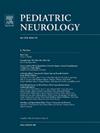Fast-Sequence Limited Magnetic Resonance Imaging Brain Protocol for Surveillance for Subependymal Lesions and Associated Hydrocephalus in Pediatric Tuberous Sclerosis Complex
IF 2.1
3区 医学
Q2 CLINICAL NEUROLOGY
引用次数: 0
Abstract
Background
Tuberous sclerosis complex (TSC) is a genetic disorder that can cause multiorgan hamartomas. The brain is often affected by cortical tubers, subependymal nodules, and subependymal giant cell astrocytoma (SEGA). Consensus guidelines recommend frequent brain magnetic resonance imaging (MRI), in the pediatric population, to monitor for SEGA. This study compares the effectiveness of fast-sequence nonsedated limited MRI with standard MRI.
Methods
Fifty-one patients with TSC had both MRIs. Two attending pediatric neuroradiologists measured subependymal lesions, lateral ventricle diameter, and changes in measurements compared with the most recent prior MRI.
Results
Sixty-five percent of patients required sedation for standard MRI. The mean age was 8.7 years. There was no significant difference between radiologists in identifying SEGA or measuring lateral ventricle size, regardless of imaging type. However, Radiologist A measured subependymal lesions smaller than Radiologist B. There was a statistically significant difference in lesion measurement on the anteroposterior (AP) view, with an average 0.6 mm smaller (P = 0.028) on limited MRI compared with standard MRI. There was no significant difference in the transverse view measurement (P = 0.77) or lateral ventricle size (P = 0.57). Additionally, there was no significant difference in the percent change of subependymal lesions over time between the two imaging types (transverse view P = 0.95, AP view P = 0.52).
Conclusions
Limited MRI reduces health care costs, repetitive sedation, and MRI scanner time, overall requiring less hospital resources. Limited MRI is clinically similar in accuracy to standard MRI. Limited MRI should be incorporated in the assessment of SEGA in pediatric TSC.
快速序列有限磁共振成像脑方案监测室管膜下病变和相关脑积水儿童结节性硬化症
背景:结节性硬化症(TSC)是一种可导致多器官错构瘤的遗传性疾病。大脑常受皮质结节、室管膜下结节和室管膜下巨细胞星形细胞瘤(SEGA)的影响。共识指南建议在儿童人群中经常进行脑磁共振成像(MRI),以监测SEGA。本研究比较了快速序列非镇静有限MRI与标准MRI的有效性。方法51例TSC患者行两种mri检查。两名儿科神经放射科医生测量了室管膜下病变、侧脑室直径以及与最近一次MRI相比测量值的变化。结果65%的患者需要镇静进行标准MRI检查。平均年龄为8.7岁。无论影像类型如何,放射科医师在识别SEGA或测量侧脑室大小方面没有显著差异。然而,放射科医生A测量的室管膜下病变小于放射科医生b。在正位(AP)视图上测量的病变差异有统计学意义,在有限MRI上与标准MRI相比,平均小0.6 mm (P = 0.028)。两组间横向视野测量(P = 0.77)和侧脑室大小(P = 0.57)无显著差异。此外,两种影像学类型间室管膜下病变随时间变化的百分比差异无统计学意义(横切面P = 0.95,正切面P = 0.52)。结论有限MRI减少了医疗费用、重复性镇静和MRI扫描时间,总体上减少了医院资源需求。有限磁共振成像在临床上的准确性与标准磁共振成像相似。有限的MRI应纳入儿童TSC的SEGA评估。
本文章由计算机程序翻译,如有差异,请以英文原文为准。
求助全文
约1分钟内获得全文
求助全文
来源期刊

Pediatric neurology
医学-临床神经学
CiteScore
4.80
自引率
2.60%
发文量
176
审稿时长
78 days
期刊介绍:
Pediatric Neurology publishes timely peer-reviewed clinical and research articles covering all aspects of the developing nervous system.
Pediatric Neurology features up-to-the-minute publication of the latest advances in the diagnosis, management, and treatment of pediatric neurologic disorders. The journal''s editor, E. Steve Roach, in conjunction with the team of Associate Editors, heads an internationally recognized editorial board, ensuring the most authoritative and extensive coverage of the field. Among the topics covered are: epilepsy, mitochondrial diseases, congenital malformations, chromosomopathies, peripheral neuropathies, perinatal and childhood stroke, cerebral palsy, as well as other diseases affecting the developing nervous system.
 求助内容:
求助内容: 应助结果提醒方式:
应助结果提醒方式:


